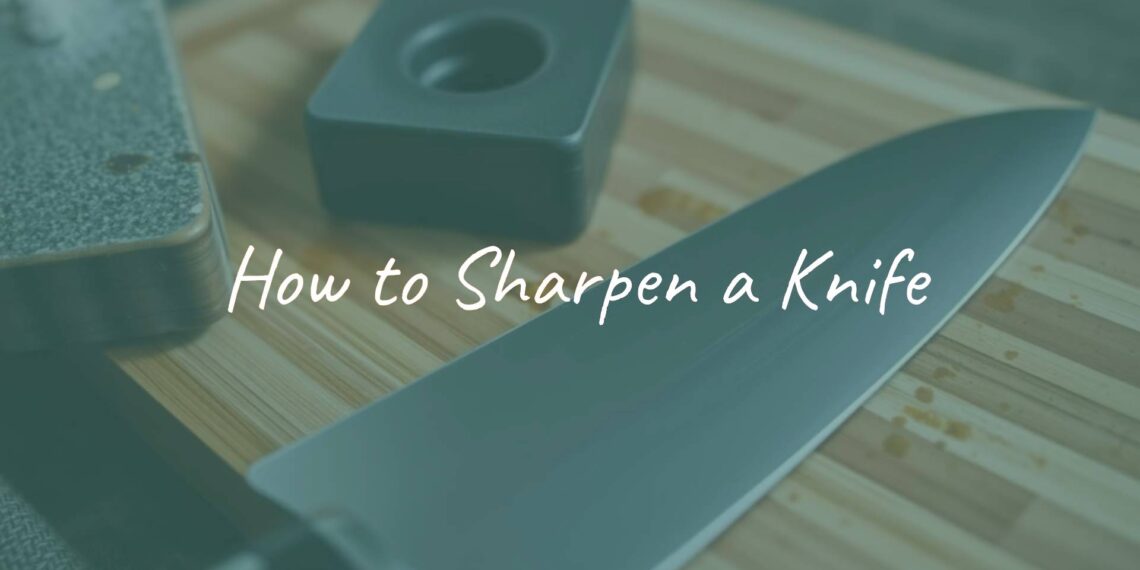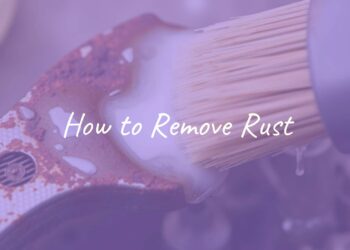Sharpening a knife means bringing back its cutting edge by grinding away a little metal to form a new, fine edge. This is important for any knife, from your daily kitchen knife to a hunting blade, because a sharp knife is more efficient and much safer. A dull blade needs more force, which makes slipping and injuries more likely. If you learn the basics of sharpening, you can turn a dull, annoying tool into one that cuts cleanly and is satisfying to use.
People have been keeping tools sharp for thousands of years; even ancient “Bog Men” carried sharpening stones as pendants. Tools and methods have changed, but the goal is the same: make an edge that cuts cleanly and with little effort. This guide explains the key ideas and steps so you can get a great edge at home.
What Does Sharpening a Knife Mean?
Sharpening removes a small amount of metal from the blade’s edge to shape it into a thin angle. With use, the very tip of the edge bends, rolls, or wears down and becomes dull. Sharpening grinds away the tired metal, exposing fresh steel and forming a new, sharp apex. You do this with abrasives, from natural stones to synthetic materials, each removing metal at different speeds and smoothness levels.
The goal is a steady angle along the whole blade so it slices with little resistance. It’s not just about making the tip pointy; it’s about forming a narrow wedge that slips between fibers instead of tearing them.
What Is the Difference Between Sharpening and Honing?
People often mix these up, but they do different jobs. Sharpening, as described above, grinds away metal to build a new edge when the old one is dull or damaged. It’s a stronger action that changes the shape of the edge.
Honing keeps an already sharp edge working well. It does not remove much metal. A honing steel or rod straightens the tiny rolled-over edge caused by use-like lining up tiny teeth. A knife may feel sharper after honing, but you did not create a new edge. Regular honing makes a sharpened edge last longer, so you sharpen less often. For example, using a steel can keep an edge sharp up to three times longer than skipping it. But a very dull knife won’t improve much with honing alone; it needs real sharpening.

How to Tell If Your Knife Needs Sharpening
Knowing when to sharpen keeps your knife working well and keeps you safe. Waiting until it is very dull makes sharpening slower and harder. The good news: there are simple ways to check sharpness at home.
A sharp knife makes kitchen work easier and less tiring. A dull one is annoying and risky. Check often so you catch dullness early.
What Signs Indicate a Dull Knife?
The clearest sign is poor cutting. If it struggles with foods it used to cut easily, it’s getting dull. If the blade slips when you chop, that’s a warning sign. For example, a dull knife crushes a tomato skin instead of slicing it cleanly, and it often snags on pepper skins.
Another sign is how hard you press. If you push harder than usual, the edge is fading. A dull edge also leaves ragged, uneven cuts, showing it is tearing instead of slicing.
How to Test Knife Sharpness at Home
Try these easy, safe tests:
- The Paper Test: Hold a sheet of paper (newsprint works well) upright. Slice from top to bottom. A sharp, non-serrated knife should cut smoothly without tearing or catching. If it snags or folds the paper, it needs work.
- The Thumbnail Test: Lightly touch the edge to your thumbnail at a right angle. If it slides, it’s dull. If it gently “bites,” it’s sharper. A key safety note: do not press hard or cut yourself. You’re feeling for light grip, not force.
- Visual Inspection: Hold the edge up to bright light. A truly sharp edge looks almost invisible. Reflections, bright spots, or nicks show dull areas or damage. The inch near the tip is often the first to dull.
Do these tests regularly, and you’ll quickly know when it’s time to sharpen, so you always work with a safe, effective tool.

Which Tools Can Be Used to Sharpen a Knife?
There are many knife sharpening tools for every skill level, budget, and blade type. From classic stones to modern electric units, knowing what exists helps you pick the right method for your needs.
Each tool has its own learning curve and strengths, so you can match your choice to your knives and your comfort level.

Whetstone or Sharpening Stone
Whetstones (sharpening stones) are classic and very flexible. They come in natural stone, ceramic, and synthetic forms, and they’re rated by grit size-the higher the number, the finer the finish. Many are double-sided, with a coarse side for shaping very dull edges and a fine side for refining and polishing.
There are “water stones” and “oil stones.” Water stones use water to float away swarf (sharpening dust), while oil stones use oil. Once oiled, a stone won’t work well with water. Whetstones give you the most control over angle, which is key to a sharp edge. They don’t cost much, take little space, and with practice, deliver very sharp results. For general use, a 1000/6000 grit stone is a good choice, and a non-slip base helps stability.
Manual and Electric Knife Sharpeners
Manual sharpeners often use V-shaped slots with ceramic or carbide abrasives at a fixed angle. They’re quick and handy for touch-ups, but some, especially those with metal-carbide bits, can remove too much metal or harm the blade over time. Systems like the Spyderco Sharpmaker or Lansky 4-rod turnbox use ceramic rods and are very beginner-friendly.
Electric sharpeners use motorized wheels or belts. They are fast and can revive very dull knives with little effort. They are less precise than stones and, if used poorly, can remove too much metal or overheat the blade and hurt the temper. Many enthusiasts prefer stones for the finest edge, but electric units are very convenient.
Sharpening Rods or Steels
Sharpening rods (honing steels) are mainly for honing, not full sharpening. They can be steel, ceramic, or diamond-coated. Their job is to straighten the rolled edge so the knife feels sharp again. A few swipes before each use can greatly extend the time between full sharpenings. They won’t create a new edge on a very dull blade, but they are excellent for daily upkeep.
Alternative Sharpening Methods
If you don’t have proper tools, some household items can help. The unglazed ring on the bottom of a ceramic plate or mug, the underside of a toilet tank lid, a brick, a flowerpot, or an emery board can act as makeshift stones. Aluminum items can help with final touch-ups because their aluminum oxide layer is mildly abrasive.
These methods are best for quick fixes or practice. They may not give you a razor edge like a fine stone, but they can make a dull knife cut better in a pinch.
Step-by-Step Guide to Sharpening a Knife with a Whetstone
Sharpening on a whetstone is a useful skill that can give you extremely sharp edges. It offers the most control and the best results, turning a dull blade into a precise cutter. It takes patience and steady hands, but the payoff is big.
You start with coarse grits and move to finer ones, slowly improving the edge until it is polished and very sharp. Each stage builds on the last.
Preparing the Stone and Knife
Get the stone ready first. For a water stone, soak it for about 10 minutes, or until bubbles stop. For an oil stone, add a thin film of sharpening oil. If your stone has no base, set it on a folded tea towel to stop slipping. Even with a base, a towel helps with water and stability.
Now check your knife. If it has heavy rust, remove it with fine sandpaper. Very dull or never-sharpened knives start on the coarsest grit you have. If the knife is already somewhat sharp and just needs a refresh, you can start with a finer grit.
Choosing the Right Angle
Holding a steady angle is probably the hardest and most important part of stone sharpening. The best angle depends on the knife. Many Japanese kitchen knives use around 15 degrees. Thicker European kitchen or hunting knives often use 20-25 degrees. A good general angle for kitchen knives is about 20 degrees.
To picture it: hold the knife at 90 degrees to the stone. Cut that in half to 45 degrees, then half again to about 22 degrees. Adjust slightly from there. A handy trick: run a Sharpie along the edge. As you sharpen, the ink disappears where the stone touches. If ink remains on the blade side, your angle is too steep; if it remains on the air side, it’s too shallow. Remove ink right at the very edge.
Creating a Burr
Your first goal is to raise a burr along the edge. A burr is a tiny wire of metal that forms on the opposite side as you push the edge into the stone. It shows you’ve thinned the edge to a fine point. Start on your coarse stone. Set the tip on the stone at your chosen angle. Draw the knife from heel to tip as if shaving a thin layer off the stone. Use steady, firm pressure. Work one side until you can feel a burr along the full length on the other side. Feel for it gently with a fingertip, brushing across the edge, not along it. If the burr is missing in spots, focus there until it appears. Then flip the knife and repeat until you raise a burr on the second side. Listen and feel for feedback from the stone.

Refining and Polishing the Edge
After you make a burr on both sides with the coarse stone, switch to a finer grit. This step cleans up the edge and removes the burr. Keep the same angle, but lighten your pressure a lot. Use alternating strokes on each side, easing up with each pass. For example, do five strokes per side, then four, three, two, and one, then move to the next finer stone. Repeat with finer grits (e.g., 1000, 4000, 6000) until the edge is polished and the burr is gone.
For even more sharpness, you can use very fine grits up to 1200 or higher, or place 600-grit emery paper on flat glass. Make a few forward strokes at a slightly higher angle (about 7 degrees), switching sides each stroke. This removes a tiny bit of metal but can improve the bite.
Testing and Finishing the Edge
Finish by stropping. Draw the blade over a leather strop (or an improvised surface like your arm with abrasive paste from flattening the stone) with the edge trailing. This removes tiny burrs or “hairs,” making the edge stronger and extra sharp, like a razor. Scratches in the strop show uneven spots; keep stropping until they fade. If scratches are big or won’t go away, do a few light passes on your finest stone and strop again.
Now test the edge. Try slicing paper. If it cuts in one smooth motion without catching, it’s ready. If it snags, find the rough spot and touch it up on the strop or go back to the stone. Wipe the blade clean after sharpening to remove any grit before using it on food.
How to Use Other Knife Sharpening Tools
Stones give you the most control, but other tools are convenient and work well for certain jobs. Learn the right way to use them so you get good results without harming your knives.
Each tool has its own method and best use, fitting different knives and user preferences.
Sharpening with a Manual Sharpener
Manual pull-through sharpeners are simple. They have V-shaped slots with abrasive wheels or rods set at a fixed angle. Place the blade in the right slot (coarse, medium, or fine) and pull from heel to tip with light, even pressure, moving away from your body. Repeat a few times. If the sharpener has separate slots for each side, alternate sides as directed, or use both sides of one V-slot.
Don’t push too hard, or you may grind unevenly or damage the edge. These are great for quick touch-ups, but cheap models can remove a lot of metal and may not give as fine an edge as a stone. With ceramic-rod systems like the Spyderco Sharpmaker, you draw the blade down and across the rods at a steady angle. These are often more forgiving than classic pull-through tools and can give an excellent edge.
Using an Electric Knife Sharpener
Electric sharpeners are fast and easy, ideal for very dull knives. Most have a couple of stages: coarse for shaping, then finer for honing and polishing. Guide the blade through the slots as the maker suggests for passes and pressure. The machine holds the angle for you.
Move the knife slowly and steadily so the abrasive can work without overheating the blade. Heat can harm the steel’s temper. Electric units are convenient, but they can remove more metal than needed. Practice on a cheaper knife first to get comfortable before using it on your favorites.
Sharpening Serrated or Specialty Knives
Serrated knives, like bread knives, are tricky because of their teeth. Pull-through sharpeners or flat stones will blunt the serrations. Use a small rod or a tool made for serrations that fits into each groove. Sharpen each tooth from the beveled side only, keeping the original angle. Deburr the flat side on a flat stone. Some people never sharpen bread knives and replace them when dull. Be careful with gadgets that claim to sharpen serrated blades.
Specialty knives-very hard steels or unusual shapes (like single-bevel Japanese knives)-may need special tools or methods. Very hard steels may need diamond abrasives if normal stones won’t cut them. Look up the needs of your specific knife before you work on it.
Common Mistakes When Sharpening a Knife
Sharpening gets better with practice, but some frequent mistakes slow you down or harm your blades. Knowing these issues helps you avoid them and get better results.
Often, fixing these errors is the difference between a so-so edge and a truly sharp one.
Incorrect Sharpening Angle
One common and harmful mistake is failing to keep a steady, correct angle. Many people say this is the hardest part. If your angle is too steep, you make a blunt, thick edge that struggles to slice. If it’s too shallow, you make a delicate edge that can chip or roll. Changing angles as you move along the blade makes an uneven edge that won’t cut smoothly.
New sharpeners often think they’re using a very low angle when they aren’t. A “7-degree” guess may be more like 12 degrees. Use a Sharpie on the edge or angle guides from some systems to build good muscle memory. Angles vary by knife (about 15 degrees for many Japanese knives, 20 for German styles, larger for hunting), but whatever you choose, keep it consistent.
Inconsistent Pressure
Another mistake is uneven pressure during strokes. Too much pressure can dig into the stone, creating uneven spots or damaging the stone. Too little, especially on coarse grits, won’t remove enough metal to raise a burr or reshape a dull edge. Use firm, steady pressure on coarse grits to raise the burr, then lighten up as you move to finer stones to refine and polish.
Pressure that changes from heel to tip leads to some areas being sharper than others. Aim for even pressure across the whole length of the blade on every pass.
Neglecting to Maintain Knives Between Sharpenings
Waiting until a knife is very dull is a big mistake. Skipping regular honing means you’ll need full sharpening more often, removing more metal each time. A few swipes on a steel before each use straightens the edge and greatly lengthens the time between major sharpening sessions.
Good habits also slow dulling. Use cutting boards softer than the blade (like wood or bamboo). Don’t chop straight down like an axe; use a smooth back-and-forth slice. Keep the edge from hitting dishes or other tools while washing or storing. Don’t toss knives in a drawer where edges chip on other utensils. These simple steps keep knives sharp longer and make sharpening less frequent.
Safety Tips for Sharpening a Knife
Sharpening involves very sharp edges and abrasives, so safety comes first. Whether you’ve done this for years or you’re new, protect yourself so you avoid accidents and have a good experience. A sharp knife is safer to use, but getting it sharp still requires care.
Safe habits also help your tools last longer and keep your food safe.
How to Prevent Injuries While Sharpening
- Always Cut Away from Yourself: Keep the blade moving away from your body, whether on a stone or through a pull-through tool. “Don’t cut toward yourself, and you’ll never get cut.”
- Secure Your Sharpening Surface: A sliding stone or sharpener is dangerous. Set your stone on a non-slip mat or damp towel. If using a clamp or jig, lock it down firmly to a steady surface.
- Mind Your Fingers: Know where your other hand is at all times. Keep fingers far from the blade’s path. When checking for a burr, very gently sweep across the edge, never along it.
- Use Protective Gear if Needed: Leather gloves can help prevent small nicks. If using oil or other lubricants, latex or nitrile gloves protect your skin.
- Go Slowly: Take your time, especially when learning. Slow, careful strokes give you better control of angle and pressure.
Cleaning and Storing Your Knife After Sharpening
Once your knife is sharp, finish with proper cleaning and storage to protect the blade and your food:
- Thorough Cleaning: Sharpening leaves tiny metal and abrasive particles on the blade. Wash with soap and water and scrub well, especially if you used lubricants. Clean the knife well before using it on food.
- Dry Immediately: Dry the knife fully right after washing, especially carbon steel, to prevent rust.
- Proper Storage: Don’t store sharp knives loose in a drawer. They dull quickly and can cause injuries. Use a knife block, magnetic strip, in-drawer organizer, or blade guards.
- Oiling for Storage: If a knife will sit unused for a while, especially carbon steel, wipe on a thin coat of food-safe mineral oil to prevent corrosion.
How Often Should You Sharpen and Maintain Your Knife?
How often you sharpen depends on the knife, how much you use it, and what you cut. A steady routine for honing and sharpening keeps blades performing well and makes cutting easier.
Treat knife care as ongoing so your tools are always ready to work.
Best Practices for Kitchen Knife Care
For daily kitchen knives, regular honing and smart use are the keys to long life and steady sharpness:
- Hone Frequently: The most helpful habit is to hone often. A few strokes on a steel before or after each use (or every few uses) straightens the edge and greatly delays the need for full sharpening.
- Sharpen as Needed: Even with honing, the edge will fade and need sharpening. For a heavily used knife, that might be every few months; for a lightly used one, maybe once a year. In busy pro kitchens like the BBC Good Food team, knives may be sharpened every couple of months. Use the sharpness tests; if honing no longer helps, sharpen.
- Use Appropriate Cutting Surfaces: Cut on wood or bamboo boards. Avoid glass, ceramic, or metal, which will dull the edge fast.
- Proper Cutting Technique: Don’t chop straight down. Use a smooth slicing motion and let the sharp edge do the work.
- Immediate Cleaning and Drying: Hand wash with soap and water and dry right away to prevent rust and stains. Avoid dishwashers; harsh detergents and heat can dull edges and harm handles.
- Safe Storage: Keep edges from bumping into other objects. Knife blocks, magnetic strips, and blade guards protect both the edge and your hands.
When to Seek Professional Knife Sharpening
Sharpening your own knives is a useful skill, but sometimes a pro is the smart choice:
- Completely Blunt or Damaged Knives: If a knife is very dull, chipped, nicked, or has a bent tip, a pro has the right tools (like belt grinders) and skill to fix it without removing too much metal or changing the shape badly. Very thick edges or very hard steels can also be tough at home.
- Specialty Knives: High-end Japanese knives, single-bevel blades, or antiques often need special methods. A pro can match their exact needs.
- As a Benchmark: If you’re new to sharpening, having a pro sharpen your knife shows you what a truly sharp edge feels like. That helps guide your own practice.
- Lack of Time or Confidence: If you don’t want to sharpen yourself, a pro service keeps your knives in great shape with minimal effort.
A good sharpening service can deliver excellent results, especially for blades that need serious repair, so they cut well again.
















![What to with Scrap Metal? [infographic]?](https://facts-homes.com/wp-content/uploads/2019/07/645413-POPYOV-391-120x86.jpg)





